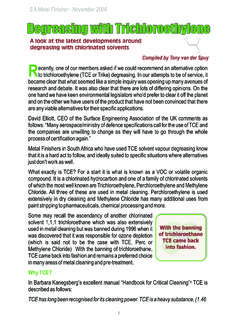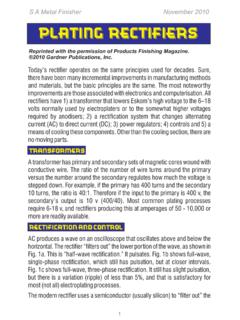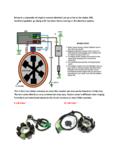Transcription of SAMFA ELECTROPLATING EXPLAINED
1 DEFINITIONBASIC ELECTROCHEMISTRYE lectroplating is a method of using an electric current to deposit a thin layer of metal over another from a solution containing a dissolved salt of the selected metal. In order for this to happen we have to create a closed circuit, an electrolytic cell, where each element in the system is of equal importance. These components are: A source of adjustable direct current, most commonly a transformer-rectifier with positive and negative terminals rigged for cable or busbar connections. In the trade this piece of equipment is usually referred to by its short name the rectifier . The electrodes that can be described as follows:?An anode connected to the positive terminal; the anode is generally composed of the material that we want to deposit. Copper in the case of copper plating, nickel in the case of nickel plating and so on. It is also possible to plate using inert anodes like carbon rods in certain cathode connected to the negative terminal; the cathode is the component on which we intend to deposit the metal.
2 In the plating workshop this is commonly referred to as the work-piece , or just the work or the job . A tank to house the plating solution containing the appropriate dissolved Figure 1 - Electrolytic CellPlating TankDC PowerSourceShuntIonsAnions migratetowards anodesCations migratetoward cathode2+Ni2+Ni+H-OH-Cl-Cl-SO24 VADirection of electron flowAmmeterVoltmeterCathodeAnodeElectrol yteELECTROPLATING EXPLAINEDB ased on information from ELECTROPLATING - A guide for Designers and Engineers available from the IMF and leaflets on plating processes published by the Surface Engineering Association as well as additional material from the ELECTROPLATING - Theory & Practice the SAMFA Training Metal Finishing Handbook 2008metal bearing salts. The correct term for this solution is the electrolyte but in the plating shop it is generally simply referred to as the solution .When the electrodes are immersed in the plating solution the circuit is com-pleted and we have all the elements of the electrolytic cell in place.
3 All that remains is to turn on the power from the rectifier, and deliver an appropriate amount of direct current to the system. This causes metal ions to dissolve from the anode and enter the solution. Metal ions are really atoms short of one or more electrons. Metal ions already in the solution, originally provided by the dissolved salt, migrate towards the cathode (the work-piece) where they collect electrons and deposit as pure metal again. These ions are replaced by those coming off the anode thus keeping the solution more or less in anodes, mentioned earlier, do not contribute metal ions to the solution. A common example of this is in chrome plating where the anodes are not fashioned from chrome, but rather from lead or a lead alloy. The lead conducts electricity into the bath which causes electrolysis to occur and chrome metal ions in the solution migrate to the cathode to deposit as chrome metal.
4 However, as no new chrome ions can be provided by the anodes, these ions have to be constantly replenished via additions of the compound commonly known as chromic acid (more correctly chromium (vi) oxide). The metal bearing salts that are used to provide the ions required are produced in chemical reactions such as those resulting from dissolving pure metal into acid, alkaline or cyanide solutions amongst others. Copper sulphate, for instance, may be produced by dissolving copper granules into warm sulphuric acid. In this case the hydrogen in the acid is driven off and replaced by the copper. The resultant precipitate exists as a lattice of copper and sulphate ions. In its dry state this metal compound awaits introduction into water when on 2+dissolving the ions will dissociate freeing up copper cations (Cu) and 2-sulphate anions (SO)4 The English physicist Michael Faraday (1791 1867) provided us with the important rules that govern electro-deposition.
5 He showed that the amount of metal deposited at the cathode and the amount dissolved at the anode are directly proportionate to the quantity of electricity passed in other words to the current and time period of the electro-deposition. Thanks to his efforts and another of his rules, Faraday's Constant, we can DEPOSITION SPEEDS ection 1 - Electroplatingcalculate the theoretical deposit weight of any metal that we are plating based on its atomic weight and the number of electrons involved in the electro-chemical reaction. [Atoms gain and lose electrons during the plating process as they do in all chemical reactions this causes them to become either positive or negative ions] This leads us to a discussion on cathode efficiency . Plating solutions that deliver the full theoretical weight of metal within a specific current/time relation-ship [the Faraday ampere hours] are said to have 100% cathode efficiency.
6 Of all the metals deposited, only silver deposits match up to the theory. All other metals have cathode efficiencies ranging downwards to as low as 12%. This is because hydrogen which is generated during the plating process also migrates toward the cathode and is released or absorbed there. So in the case of a plating solution that proves to have 80% cathode efficiency, the balance of the deposit is made up of 20% cathode efficiency explains why chrome solutions gas so furiously during plating, giving rise to large amounts of hazardous aerosol. This has to be dealt with through one or another mechanism, both to protect workers and con-serve the solution. It also explains gas-trapping where hydrogen gathers in awkward low current density areas blocking the passage of metal ions. Much work has been done on proprietary addi-tives to help overcome this problem in chrome plating and modern additives can double the inherent cathode of this hydrogen bubbling away vigorously at the cathode is liberated into the atmosphere.
7 But some of it is absorbed at the cathode into the work-piece. If this happens to be a hardened high-carbon steel component, the entry of this hydrogen into the structure of the metal can lead to what is known as hydrogen embrittlement . As the hydrogen rearranges itself within the structure, the internal stresses set up are often enough to cause a part to fracture with no external force being applied. Even if the part does not fracture on its own, it may easily do so with the application of minimal external stress. It is easy to see the CATHODE EFFICIENCYHYDROGEN EMBRITTLEMENTLow current efficiency describes why chrome solutions gas furiously during platingSAMFA Metal Finishing Handbook 2008potential for catastrophic consequences in safety critical components. Potential hydrogen embrittlement can be reversed by heat treatment immedi-ately after plating to drive the hydrogen out before it can cause any harm.
8 If it is left for any length of time, the damage becomes a current is applied to a load of work the distribution of current is not uniform over the whole area. If an area of 1 square decimetre is plated at 4 amps the average current density is 4 amps/dm but the true density at any one spot (the local current density) may vary widely. The actual variation will depend on the shape of the part and the arrangement of the anodes; even with the simplest of shapes a flat sheet the variation will be not less than 2:1. It will be greater with more difficult shapes such as a tube where little or no current will reach the inside. By using specially designed anodes the current distribution can be improved. Such conforming anodes are discussed in the paragraphs as there is a preferred range of cathode current densities for each plating solution so there is a correct range for anode current density. Too high a density can cause the formation on the anode of an insulating film (usually oxide), which can lower the current and cause other troubles.
9 Too low a density is also to be throwing power of a plating solution is a measure of the ability of that solution to plate to a uniform thickness over a cathode of irregular shape. Remember that the work being plated is the cathode so an irregularly shaped cathode refers to an awkwardly shaped piece that has to be processed. If such a cathode (or piece of work) is plated to a uniform thickness over its entire area the solution would be said to have a perfect throwing power. If it plated only on those areas nearest to the anodes then the solution has a very poor throwing power. All plating solutions fall somewhere between these two extremes and can be classified as good , medium or poor .METAL DISTRIBUTIONTHROWING POWER1 micron at centreAt least 2 microns in the cornersSection 1 - ElectroplatingEven on a flat sheet the variation will not be less than 2:1 SAMFA Metal Finishing Handbook 2008 AnodeAnodeWorkpiece/CathodeLow currentdensity areasUsing a Conforming AnodeConformingAnodeAnodeWorkpiece/Catho deTo improve throw, a conforming anode may be fashioned to bring the anode in closer proximity to the low current density areas.
10 In this manner it is possible to considerably improve the deposit thickness in areas where solution throw is highlight the low current density areas in a channel shaped component. The plated deposit is represented by the orange area encapsulating the work piece. Note that the thickness in this region is considerably less than elsewhere and is directly linked to the ability of the soluton to throw into such a recessed is always desirable to secure an even thickness of plating or uniform metal distribution. The metal distribution depends mainly on the distribution of current, which we know to be uneven; there will, for this reason, be a corre-sponding uneven thickness of plating. Any measure taken to make for better current distribution will also yield a more uniform plating thickness. One such method would be to construct a conforming anode; that is an anode that is constructed to follow the shape of the piece being plated.








